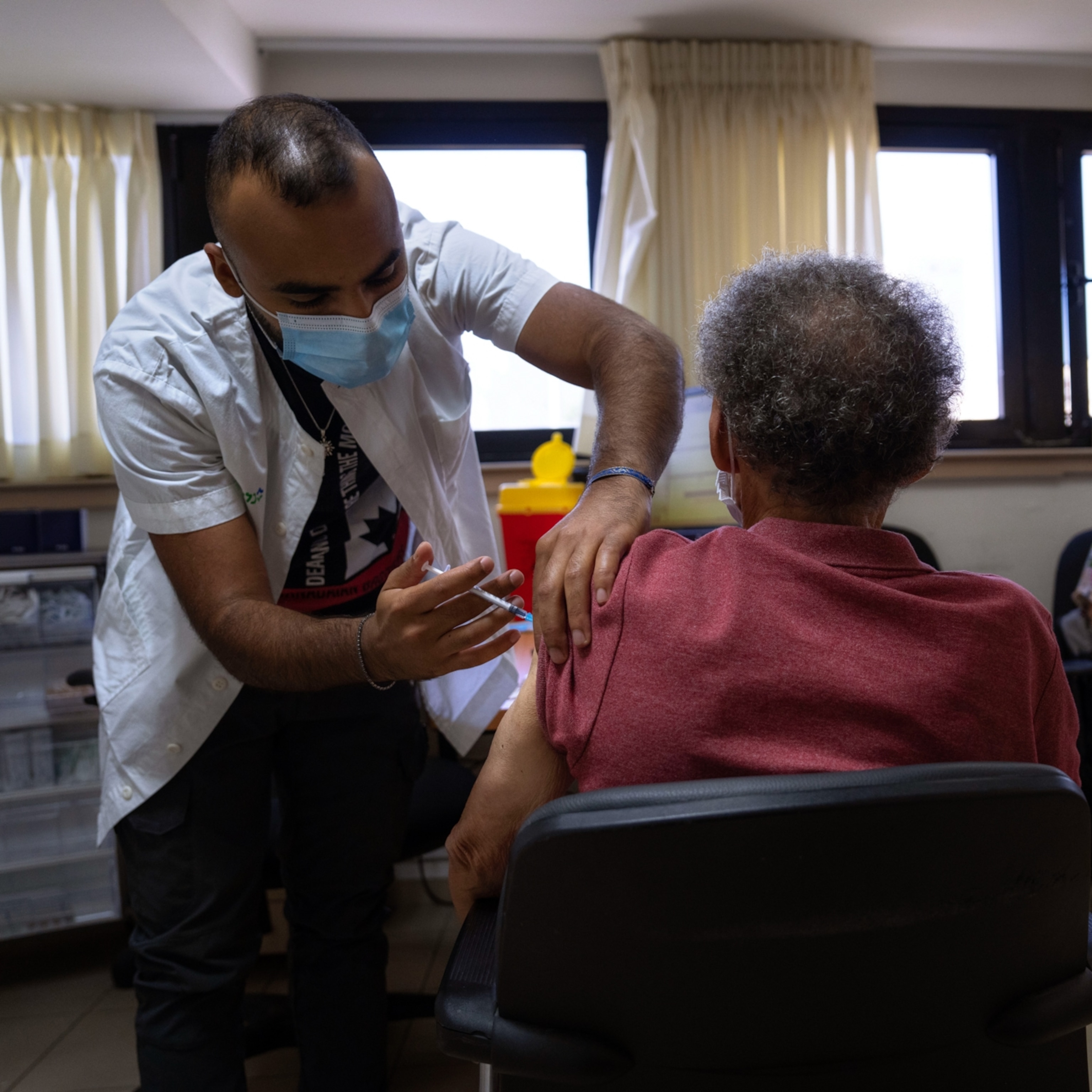
Why Omicron variants BA.4 and BA.5 are causing fresh U.S. outbreaks
More infectious than past strains, these subvariants can also more easily escape antibodies from vaccines and previous infections.
Two Omicron subvariants are now causing more than half of new coronavirus infections in the United States—and both are very good at dodging antibodies in people who have been vaccinated and boosted, as well as in people who had a previous COVID-19 infection.
First spotted by scientists in South Africa in January and February this year, the BA.4 and BA.5 subvariants became dominant in the U.S. in less than two months, according to this week’s estimates from the U.S. Centers for Disease Control and Prevention. For the week ending on June 25, BA.4 accounted for 15.7 percent of new cases, while BA.5 was responsible for 36.6 percent.
“BA.4/BA.5 certainly is more infectious compared to previous Omicron variants,” says Yunlong Richard Cao, an immunologist at the Biomedical Pioneering Innovation Center at Peking University in Beijing, China. Cao’s research shows that one of the most concerning traits of these variants is their ability to evade the immune system and break through herd immunity.
That’s of particular concern because almost a quarter of the eligible U.S. population has not received a vaccine of any kind. And for those who have, even a full dose doesn’t seem to sufficiently block the new variants.
“Two doses do not offer much in terms of protection against BA.4 and BA.5,” says Shan-Lu Liu, a virologist at the Ohio State University in Columbus. A little over half of U.S. adults have received their first booster dose, but more than 30 percent of those over 65 have not, and they are at high risk for COVID-19 infection or reinfection.
Despite this concern, experts stress that vaccines and boosters are not completely ineffective: “Immunity from current vaccines is still expected to provide robust protection against severe disease, hospitalization, and death,” says Dan Barouch, an immunologist at Harvard Medical School in Boston.
How much do these subvariants dodge immunity?
In addition to Cao’s work, multiple studies are showing that BA.4 and BA.5 excel at dodging antibodies.
“Following [even a] third dose of the Pfizer vaccine, BA.4 and BA.5 escaped from vaccine-induced and infection-induced antibodies more effectively than prior Omicron variants,” says Barouch. His research also shows that BA.4 and BA.5 can effectively dodge antibodies created after Omicron breakthrough infections in vaccinated people.
Liu’s research shows that people who received just two doses of either mRNA vaccine did not produce sufficient antibodies to block any Omicron subvariant, including BA.4 and BA.5. While a booster dose significantly improved protection, it was still less efficient against BA.4 and BA.5.
And in a study that is not yet peer reviewed, Alex Sigal, a virologist at the Africa Health Research Institute and at the University of KwaZulu-Natal in Durban, South Africa, found that antibodies from a previous infection with the original Omicron BA.1 strain do not protect against BA.4 and BA.5 infection in either partially vaccinated or unvaccinated people.
What makes BA.4 and BA.5 different?
While BA.4 and BA.5 are almost identical to each other, BA.5 spreads even faster than its “twin” and all other Omicron variants, according to the data from the United Kingdom.
The two variants differ from the Omicron BA.2 subvariant by just six mutations within the spike protein—the part of the SARS-CoV-2 virus that anchors to receptors on human respiratory cells and allows the virus to enter.
Kei Sato, a virologist at the University of Tokyo, has shown that one of these mutations helps the virus anchor to human cells and replicate better.
“It's quite a useful sort of mutation for the virus,” says Ravindra Gupta, an immunologist and infectious disease specialist at the University of Cambridge in the U.K. Sato and Gupta’s work has shown that this mutation weakens the potency of existing antibodies.
Sato’s unpublished research also indicates that in hamsters, BA.4 and BA.5 target lung tissues more efficiently than previous Omicron variants. But it’s too early to say whether BA.4 and BA.5 can cause more severe diseases in humans, says Olivier Schwartz, a virologist and immunologist at the Pasteur Institute in France.
In South Africa, the surge in infection caused by BA.4 and BA.5 did not lead to as many hospitalizations as the original Omicron wave, says Tulio de Oliveira, a bioinformatician at Stellenbosch University in South Africa who discovered the Omicron variants.
“We do know that it didn't really drive much of a severity wave in South Africa, which is somewhat reassuring,” says Gupta, “although they're a much younger population.”
In Portugal, on the other hand, where BA.5 now accounts for almost 90 percent of infections, hospitalization and intensive-care admissions have risen during the past six weeks, mainly among people ages 60 years and older.
What’s next for the vaccines?
Both Moderna and Pfizer have developed new types of “bivalent” boosters that are based on both the Omicron BA.1 subvariant and the original version of SARS-CoV-2 used in the approved shots.
It’s unclear how the updated bivalent booster will fare against BA.4 and BA.5, since both the Moderna and Pfizer boosters generated a weaker antibody response to these subvariants than to BA.1. The U.S. Food and Drug Administration has admitted that the bivalent booster is "already somewhat outdated."
Regardless, an FDA advisory panel recommended on Tuesday to start using the updated COVID-19 booster shots in the fall.
Along with improvements to the vaccines, preventive strategies such as social distancing, avoiding crowded indoor places, and masking remain very effective at reducing infection risk and decreasing the likelihood that new immunity-evading variants will evolve.
“Waning vaccine immunity and decreased masking are also major contributors to the continued circulation of the virus,” says Barouch.
"We just have to be a bit careful in our daily life," says Sigal. "COVID-19 is not done."
Related Topics
You May Also Like
Go Further
Animals
- Behind the scenes at America’s biggest birding festivalBehind the scenes at America’s biggest birding festival
- How scientists are piecing together a sperm whale ‘alphabet’How scientists are piecing together a sperm whale ‘alphabet’
- Orangutan seen using plants to heal wound for first timeOrangutan seen using plants to heal wound for first time
- What La Palma's 'lava tubes' tell us about life on other planetsWhat La Palma's 'lava tubes' tell us about life on other planets
Environment
- The northernmost flower living at the top of the worldThe northernmost flower living at the top of the world
- This beautiful floating flower is wreaking havoc on NigeriaThis beautiful floating flower is wreaking havoc on Nigeria
- What the Aral Sea might teach us about life after disasterWhat the Aral Sea might teach us about life after disaster
- What La Palma's 'lava tubes' tell us about life on other planetsWhat La Palma's 'lava tubes' tell us about life on other planets
- How fungi form ‘fairy rings’ and inspire superstitionsHow fungi form ‘fairy rings’ and inspire superstitions
History & Culture
- This thriving society vanished into thin air. What happened?This thriving society vanished into thin air. What happened?
- These were the real rules of courtship in the ‘Bridgerton’ eraThese were the real rules of courtship in the ‘Bridgerton’ era
- A short history of the Met Gala and its iconic looksA short history of the Met Gala and its iconic looks
Science
- Why trigger points cause so much pain—and how you can relieve itWhy trigger points cause so much pain—and how you can relieve it
- Why ovaries are so crucial to women’s health and longevityWhy ovaries are so crucial to women’s health and longevity
Travel
- 6 of the best active pursuits on Cape Cod and the Islands
- Paid Content
6 of the best active pursuits on Cape Cod and the Islands - The key to better mindfulness may be your public gardenThe key to better mindfulness may be your public garden
- How to spend a weekend in Kitzbühel, Austria
- Paid Content
How to spend a weekend in Kitzbühel, Austria







